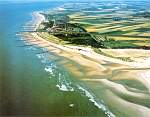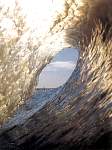Introduction

| European Coasts - An Introductory Survey Introduction
|
|
 |
 |
 |
| Cadzand, the Netherlands | Fig 1: Spectacular view through a plunging breaker (Book of Waves, Arpel Graphics, California) | Fig 2: Storm surge at Sylt |
This book of photographs mainly provides a survey of various features of the European coasts. The book is used at various European universities alongside regular textbooks on Coastal Engineering. The book aims to give an impression of the breath of the field of Coastal Engineering, to deepen interest in this field and to extend the knowledge of local coastal features by providing details of other European coasts. The various aspects which plays a role in coastal engineering are briefly mentioned in the accompanying text. The book is no textbook: it does not provide a theoretical background. However, it forms a rich illustration to accompany existing textbooks.
English has been chosen as the language of this book. This choice as drawbacks for students in some countries. In order to help with reading, a glossary of the main Coastal Engineering terms in various languages has been provided.
The photographs in the book originate mainly from European sources. This restriction is rather severe, since the various aspects of Coastal Engineering can be illustrated as well, sometimes even better, with photographs from other regions. Nevertheless, the choice has been made to illustrate this book with photographs from the student's own country or from neighbouring countries.
In the first chapter, the wide variety of European coasts and the main type of coastal profiles and formations are shown. The intense and varied human activities in the coastal area are also shown. In the second chapter the various physical processes that occur in the coastal region are illustrated. These processes include the effects of the tide, waves, storm surges and sediment transport. Various theories which explain the processes are briefly mentioned without explaining their backgrounds. The interaction of coastal processes and human activities is illustrated in chapter 3. Various photographs show the effects of construction work on the coastal processes, for example the development of scouring holes. Also the effect of other human activities such as land subsidence due to mining are illustrated. In chapter 4, common Coastal Engineering structures are shown. Finally, several major recent projects are presented in chapter 5. This provides a "state of the art" impression of European Coastal Engineering.
previous page table of contents next page
| This page is from the book "European Coasts", produced in the framework of the Erasmus project under EC contract ICP 92-G-2013 and placed on the Internet in the framework of the PIANC-MarCom initiative on Education. |